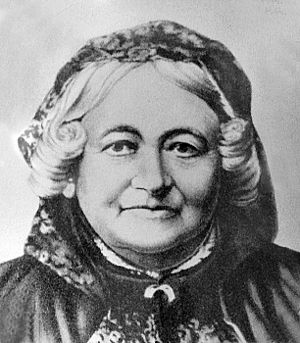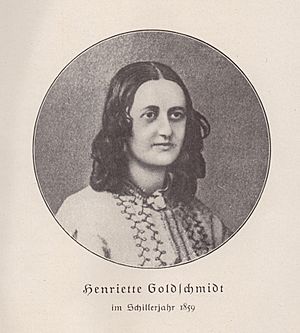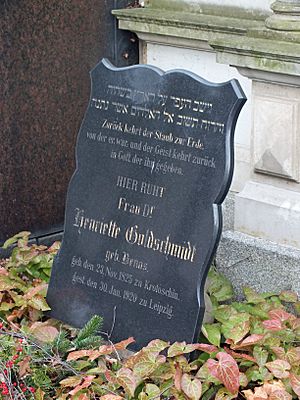Henriette Goldschmidt facts for kids
Quick facts for kids
Henriette Goldschmidt
|
|
|---|---|

circa 1910
|
|
| Born |
Henriette Benas
23 November 1825 Krotoschin, Province of Posen, Kingdom of Prussia
|
| Died | 30 January 1920 (aged 94) |
| Nationality | German |
| Occupation | education activist, women's rights activist and social worker |
| Years active | 1865–1917 |
| Known for | founding first higher education school for women in Germany |
Henriette Goldschmidt (1825–1920) was an important German Jewish woman. She was a feminist, which means she worked for equal rights for women. She was also a teacher and a social worker.
Henriette Goldschmidt helped start the German Women's Association. She worked hard to make sure women could get a good education and find jobs. She even started the first school in Germany that offered higher education for women.
Contents
Early life and education
Henriette Benas was born on November 23, 1825. Her hometown was Krotoschin, which was in Prussia at the time. Her parents were Eva and Levin Benas, a Jewish merchant. Sadly, her mother died when Henriette was only five years old.
Henriette finished school at the Höhere Töchterschule when she was 14. This school mostly taught girls how to be good housewives. But Henriette wanted to learn more. She read German classic books and the Breslauer Zeitung newspaper. This made her interested in politics from a young age.
In 1853, Henriette married her cousin, Abraham Meir Goldschmidt. He was a rabbi and had three sons. Five years later, her husband became the rabbi in Leipzig, and the family moved there.
Working for women's rights
Moving to Leipzig felt like a new beginning for Henriette. She quickly became involved in the Jewish community. She also learned about the ideas of Friedrich Fröbel. He was famous for starting the kindergarten system for young children.
Henriette's husband encouraged her to follow her interests. She studied history, literature, teaching, and philosophy on her own. In 1865, she joined Louise Otto-Peters and Auguste Schmidt. Together, they organized a meeting for German women. From this meeting, they founded the German Women's Association. Their goal was to make women's lives better.
Henriette was at first unsure about joining the board of the group. At that time, women were not allowed to vote in volunteer groups. But with her husband's support, she became a very active member. She served on the board from 1867 to 1906. During this time, she gave many speeches for the organization.
Pushing for education and jobs
In 1867, Henriette Goldschmidt started petitions. These were sent to the Reichstag (the German parliament). The petitions asked for women to have better access to education and jobs. She also signed a petition to protect children born outside of marriage. She believed women should be part of their communities. She felt women could bring a special understanding to difficult social issues.
The next year, she suggested that women should do a year of social service. In 1871, Goldschmidt founded the Society for Family Education and for People's Welfare. This group aimed to train kindergarten teachers using Fröbel's methods. She was the president of this organization for more than 40 years. By 1872, the group was holding teaching workshops. They also opened a public kindergarten.
By 1878, she started the High School for Ladies (Lyzeum für Damen). Professors from the University of Leipzig gave lectures there. At that time, women were not allowed to go to university. Only a few private schools offered education, and it was often not very good. Hundreds of women attended these lectures. This gave them a chance to get an education and even become teachers.
In 1889, the Jewish community helped buy a house for Henriette's organization. This house became her home after her husband passed away. It also became a hub for women's education. It offered courses, lectures, and social events. Some members of the association also lived there, like the writer Josephine Siebe.
In 1898, Goldschmidt and Auguste Schmidt asked the German Women's Association to support a petition. They wanted the Fröbel kindergarten method to become the official state education system. The petition asked for kindergartens to be standardized and supervised by the state. It also asked for all children to attend. Many people were against this idea. They felt it would take away parents' rights to raise their children. They also worried about children from different social classes mixing. Henriette defended her plan in a publication in 1901. But the plan was eventually defeated.
Higher education for women
Henriette Goldschmidt did not give up. She kept writing and speaking about the need for kindergartens and women's education. In 1906, women were finally allowed to study at universities in Germany. However, Henriette believed that university courses did not fully prepare women for their roles in society. She thought women had a natural calling to improve society through their cultural involvement.
She wanted to fill this gap, not compete with universities. In 1911, she reached a major goal in her career. She established the first institution in Germany that offered higher education specifically for women. This was the Leipzig College for Women.
The college's classes were designed for women. They aimed to teach women to take part in the intellectual life of their culture. They also prepared women to be successful mothers and teachers. The goal was to help women understand their community's needs and develop skills for charity work. Again, professors from the University of Leipzig helped with the courses. Henriette Goldschmidt herself taught classes between 1911 and 1913. After the 1916-1917 school year, Henriette retired. She handed over the school to the Saxon Ministry of Worship and Public Instruction.
Henriette Goldschmidt passed away on January 30, 1920, in Leipzig. She was buried in the Old Jewish Cemetery of Leipzig.
Legacy and recognition
In 1921, the clubhouse of the Society for Family Education and for People's Welfare was renamed the Henriette Goldschmidt House. This was done to honor her. However, that same year, the society merged with the Henri Hinrichsen Foundation. Henri Hinrichsen then took charge of the school.
During the Nazi era, the school tried to hide any connections to its Jewish founder, Henriette Goldschmidt. They also barred Jewish girls from attending. After East Germany was formed, the school was renamed after Henriette Goldschmidt again. It became a training school for kindergarten teachers. In 1992, the school, now called the Henriette-Goldschmidt Vocational School, became a technical training center for social work and special education.
Even though the school survived, the Henriette Goldschmidt House was torn down in 1999. This happened despite protests, for a road expansion that never took place.
There are two public plaques in Leipzig that honor Henriette Goldschmidt. One was put up in 1986 at the entrance to the Henriette Goldschmidt School. It says that the Academy of Women opened there in 1911. It mentions Henriette Goldschmidt as the founder and Dr. Henri Hinrichsen for his financial support. The second plaque was placed on a house in 1996. It marks the spot of the first children's day care center.
In 2001, a statue (bust) of Henriette Goldschmidt was made. The original is in the Leipzig Museum of Fine Arts. A copy is at the Henriette Goldschmidt School. It has a plaque with the words "To the noble pursuit of German women," which was originally added by Hinrichsen.
Selected works
See also
 In Spanish: Henriette Goldschmidt para niños
In Spanish: Henriette Goldschmidt para niños




